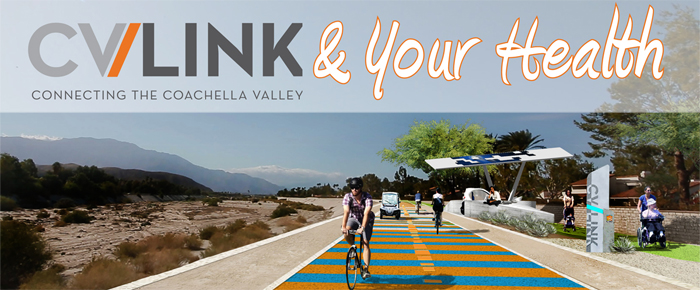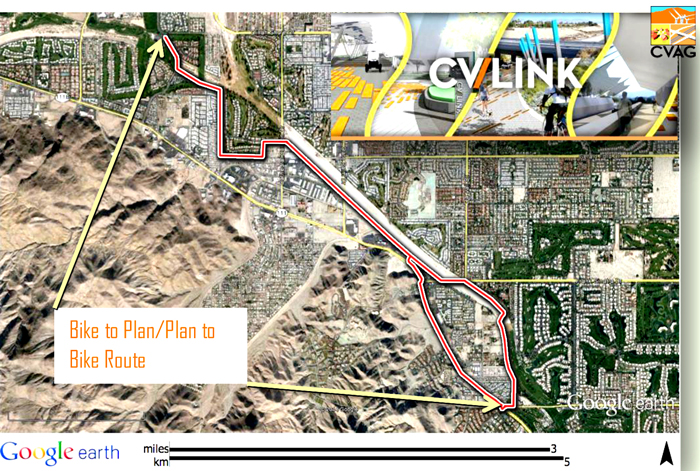
The Coachella Valley Association of Governments (CVAG) in partnership with the Riverside County Department of Public Health and the Southern California Association of Governments are conducting a Health Impact Assessment of the CV Link project and will hold a series of public workshops starting next week to discuss how the CV Link design can be improved to promote community cohesion and identity, increase physical activity, improve transportation access, increase economic development and contribute to better air quality.
The first workshop will take place on October 28th from 5:30 p.m. to 7:30 p.m. at the College of the Desert Cravens Student Services Center located at 43-500 Monterey Avenue, Palm Desert, CA 92260. The workshop is free to the public and all Coachella Valley residents, employees, business owners, government officials and advocates are encouraged to attend and share their ideas. No prior knowledge of CV Link or community health is required. The workshop will be bilingual in English and Spanish and a light dinner will be served.
The second workshop will take place on November 12th from 6:00 p.m. to 8:00 p.m. at Bobby Drake Middle School Cafeteria located at 85358 Bagdad Street, Coachella, CA 92236.
The third workshop will take place on November 13th from 5:30 p.m. to 7:30 p.m. at Cathedral City Hall City Council Chambers located at 68700 Ave Lalo Guerrero, Cathedral City, CA 92234.
For information about CV Link, please visit www.CoachellaValleyLink.com and find us on Facebook and follow us on Twitter with the handle @CV_Link and hashtag #CVLink.
A Health Impact Assessment of Coachella Valley Link
The Coachella Valley (CV) Link will be a 50- ‐mile multi- ‐modal transportation path connecting eight cities and three Native American tribes in the Coachella Valley. Located in north- ‐central Riverside County, California, the path will be open to bicycles, pedestrians, and low- ‐speed electric vehicles (LSEVs) including golf carts and neighborhood electric vehicles (NEVs).
Construction for the CV Link is projected to begin in 2016. The planning process is led by Coachella Valley Association of Governments (CVAG) and is currently underway. A final Master Plan to be completed in late 2014 will guide the design, construction, and management of the CV Link Project and has been informed by public input and environmental analysis. Environmental review in compliance with the California Environmental Quality Act (CEQA) and the National Environmental Policy Act (NEPA) will also be completed.
Plan proponents have advocated several benefits of the path including its capacity as a transportation resource, thus relieving congestion on nearby Highway 111 and improving air quality; its role as an access corridor for employment, shopping, and school; its contribution as an opportunity for Fitness and recreation; and its economic benefits through projected design, construction, and maintenance jobs and as an amenity for the tourism industry.
Southern California Association of Governments (SCAG), CVAG, and the Riverside County Department of Public Health (RCDPH) are commissioning a health impact assessment to use multiple data collection and analysis methods to determine the potential positive and negative health effects of this project on the Coachella Valley community. Human Impact Partners has been hired to conduct the analysis.
Health Impact Assessment (HIA) is a practical approach that uses data, research, and stakeholder input to determine a policy or project’s impact on the health of a population.
Goals and Objectives
The HIA will be conducted concurrently with the next phase of CV Link planning, and in addition to highlighting potential health impacts of the CV Link, the HIA will provide recommendations for maximizing health benefits of the path and monitoring and managing any identified potential negative impacts. In this way, the HIA will directly inform design features of the path.
The HIA may evaluate the CV Link’s influence on:
• physical activity
• air quality
• economic development
• social cohesion
• community identity
The HIA will analyze health impacts for communities with unique health statuses and concerns, including low- ‐income communities and Native American tribes near the path.
Community participation
In addition to partnerships with CVAG, SCAG, and RCDPH, the HIA process will engage partners such as local community- ‐based organizations and residents, community councils, businesses, and public agencies through four community workshops, with the intention of building relationships, elevating community voices about health issues and priorities, and “groundtruthing” HIA findings and recommendations.













































